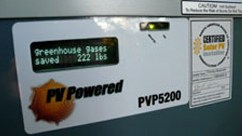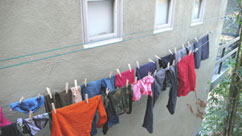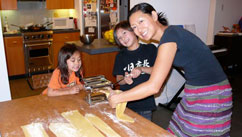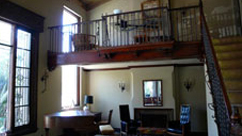 |
By Richard Seireeni |
|
|
|
Reducing Our Carbon Footprint Step By Step by Richard Seireeni, Brand Architect July 8, 2008 |
||||
Making an effort to reduce our carbon footprint at home has turned out to be a rather protracted process of making incremental product choices and some overall changes in lifestyle. I'd like to share a few of our family experiences in our quest for sustainability. Greening Our Ride In 2006 and after much prodding from my wife, I started looking for a family car she could drive that didn't require fill-ups at the gas station. We were looking for a diesel wagon that we could convert to run on pure vegetable oil. That search led me to Houston via eBay where I ended paying a premium price for a 1983 Mercedes turbo-diesel wagon with very low miles. Sixteen thousand dollars for this 82,000 mile beauty, to be exact. The story was that it had only been driven on Sunday's by an aerospace engineer to ferry his foursome to their golf games. Yeah. Right. Well, it turned out be a nice, clean car that made the two-day cruise back to Los Angeles with no problems. We had it converted at Lovecraft Biofuels for about $800 and bought a 55 gallon plastic tank to store and filter the used oil we planned to get from local restaurants. So far so good. The problem is getting the used cooking oil. It's in hot demand here, so few restaurants near us have much. It's sticky and very hard to pump. And filtering takes a fair amount of time and the willingness to get a bit greasy. So, now we buy mostly virgin soy oil from Costco and occasionally some bio-diesel from the Conserv alternative fuels station in Brentwood. In the end, we've transfered our carbon guilt from Chevon and Mobil to Cargill, the folks behind the soy field clear cutting in Brazil. Argh! Our pre-Veggie Burner cars are still with us. Both are gas-guzzlers that we plan to phase out as soon as the automakers start delivering a plug-in electric hybrid family car that is long distance capable. We want one fuel efficient car that we can drive around town and take on ski trips to Mammoth with a load of kids and gear. So, we bide our time and pay the very high cost of repair that comes with owning a twenty-five year-old German car. The Slow Food Movement in Our Kitchen My wife loves to cook and has really ramped up after our kids gave her the Alice Water's book, The Art of Simple Food, for Christmas this year. Simple, because we are both short on time. Organic. In Season. Local. That's what she's all about these days. We are also doing the usual green things: trips to the local farmer's market; shopping at Whole Foods (whole paycheck) along with Trader Joe's and Costco for other staples; making our own bread, pizza dough and pasta; reducing our consumption of meat; being aware of the fish we buy; avoiding heavily packaged or overly processed foods; and, composting. Composting is actually a sore issue around our house. We live on a wooded hillside, so I like baseball style composting. I.e., tossing it out into the woods. My wife hates this. Says it attracts rats. But in all the years I've doing this, I've never run across any of my discards. It all vanishes into what I consider the 'food chain'. You know . . . orange rinds eaten by rats, rats eaten by our endangered red-tailed hawks, hawk poop re-fertilizes the soil. What I appreciate most about what my wife does, aside from providing tasty and healthy meals, is her encouragement of family participation in making food. She involves the kids in making the pizza dough and rolling out the pasta. Even though they are only 3 and 7 years-old, they help with making sauces and other food prep. They're junior sous chefs. My boy also joins me in trips into our neighbor's orchard where he has generously allowed us to pick oranges and grapefruit that we then make into jams and fruitsicles. We live right in the heart of Los Angeles, but the rural quality of Laurel Canyon gives us an opportunity to live just a wee bit closer to the land. The Sun Use To Cook The Roof, Now It Cooks Up Power Yes, we installed solar panels this year, but save the congratulations until all the evidence is in. This was expensive even with the 50% subsidies we earned from the utilities. And because of a neighbor's tree, we are getting much lower output in the winter than expected. Nevertheless, the highlight of the day is passing the inverter mounted in the driveway and checking its performance. The designers of these things had the sense to add a realtime LED readout that lists the greenhouse gasses saved to date. That number seems to distract me from thinking about the numbers in my checkbook register. So, assuming this thing starts to produce in the spring and summer, we hope that solar will be our renewable energy source when we ultimately convert to a plug-in hybrid or all-electric vehicle. Instead of coal, we will be supplying our transportation energy from the sun. And as for the roof. Well, the panels do seem to add a layer of insulation, keeping the inside of the house a bit cooler on hot days. Buy Once, Use a Lifetime One thing we've tried to do is buy classic, often used, furniture and keep it. We have quite a few Mid-century Modern pieces, most of which are originals. Buying classics helps us avoid the boredom problem when a trendy piece goes out of style. The other thing I do is make furniture. I'm pretty handy and have made quite a few pieces for our home and office. It's another way to avoid unnecessary consumption. When you put sweat into making something, you have less incentive to switch it out for something new. Hung Out To Dry I dunno, I guess I read somewhere that the dryer uses a lot of energy. Ours is gas but uses electricity as well to turn the drum. With two kids, we end up doing a lot of laundry and presumably using a lot of energy. It also seems a shame to waste all this sunny Southern California weather that is perfect for drying clothes quickly. But the more consuming issue is all that lint we pick out of the trap. That's our clothes dissolving away! So, I rigged up a clothesline on the side of the house. Maybe it will become the next hip thing. I can imagine the real estate agents encouraging their sellers to install a clothesline - in addition to solar panels - to increase the value of their homes. Well, hopefully our clothes don't bother our neighbors. We also wash all colored clothes in cold water and use the Whole Foods in-store brand of liquid laundry soap. For whites, we use the concentrated Tide alternative bleach soap. So, between the cold water, the mild soap and the air drying, I think our clothes are smelling better and lasting longer. The Family Bath Once a week, we love to take a family bath in our Japanese style tub. Called an ofuro, a Japanese tub is made out of hinoki wood, which is a kind of cedar. We had ours made out of Alaskan white cedar, which is similar. I've included our bathing habits because in our house, like in a traditional Japanese bathhouse or onsen, we wash up and rinse outside the tub, and then use the heated tub to soak together. Instead separate baths for each family member, we use one tub of water everyone. It's sorta, kinda green, but more than that, it's a whole lot of fun. Oh, I forgot to mention that our ofuro is not built in. It's freestanding, not unlike those old freestanding iron tubs with feet. If we ever move, we can take this with us as though it were furniture. This tub, with care, should last several lifetimes. Let's Talk About Those Pig-tail Light Bulbs I've been experimenting with different brands and different configurations of CFL's. From The Home Depot, I found some reasonably warm and frosted types that will work in the recessed fixtures in the kitchen and bathroom. They are not dimmable, so I had to remove the dimmer controls. They also take a while to warm up. I also put a couple outside in the recessed cans in the carport. One failed within a year, but I have written this off to the fact that they are not outdoor rated. We also ordered six TCP branded dimmable bulbs for the living room chandelier. They do dim, but not completely. The range is from about 30% to 100%, and the bulb is very bright if it is in your field of view. I'll be watching to see just how long they last, as I've heard that dimmable bulbs don't perform as well as non-dimmable types. I did consider the latest LED bulbs, but they are still quite expensive. Let The Sun Shine In Skylights. What a difference a little natural light makes. For years we were turning on the lights in the middle of the day even though our house has large windows on two sides. The issue is the directions those windows face. One wall is north and the other east. We don't get the southern light blasting into the living room, but it's also not so bright — until we installed the four skylights in the ceiling. In addition to the natural light during the day, we are saving energy; and, they don't take that much maintenance. Just a quick cleaning two or three times a year keeps them fairly clear. Just Bag It My wife has made it an article of faith that we use no bags, paper, plastic or otherwise. Each car is packed with cloth or nylon shopping bags, and there is hell to pay if one of us walks into the house with purchases tucked into disposable bags. So, I was particularly happy to hear that Whole Foods has announced that it will no longer offer plastic shopping bags. I'll continue to add to this as we make more green progress. It's a step by step process. © Rick Seireeni, Brand Architect and President The Brand Architect Group is a strategic brand consultancy with offices in Los Angeles, Tokyo and Shanghai. Project specialties include retail, food service, banking and real estate development.
|
Just a few of the things we do around our home. We drive a veggie-powered old Mercedes wagon. Shopping locally and organically at the local farmers markets is our Sunday morning ritual. As we have solar on the roof, checking the LED for 'greenhouse gases saved' is a daily comfort. And, yes, we line dry our clothes. They smell better, last longer. And, making pasta the Slow Food way.
Even our office is recycled. My wife and I run our businesses out of a studio loft building built in 1922. Articles by Richard Seireeni: |
![]()






